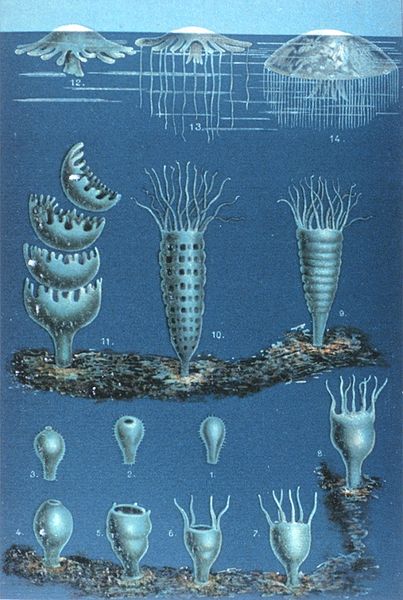
Jellyfish life cycle
Sea jellies (aka jellyfish) have a very interesting life cycle. The first part is somewhat old-fashioned, adult male sea jellies release sperm into the water and adult female sea jellies release eggs and the eggs and sperm meet up and join together Biology 101 style. But the details on how eggs and sperm find each other vary.
A Scientific American article and National Science Foundation fact sheet describe sperm and eggs joining together in the ocean, but the Animal Corner website describes sperm swimming into the female’s mouth to fertilize the eggs and the Jellyfish Facts website also details something similar and states that the fertilized eggs are stored in the female jelly’s stomach. For moon jellies the story is slightly different, fertilized eggs are stored in pits along the oral arms, which are the four tentacles that hang from the mouth.
Fertilized eggs grow to become tiny, tiny critters called planula larvae that swim and are also carried by ocean currents. Planula larvae stay free floating for hours or several days and eventually settle down and attach to some type of hard surface such as a rock. Once attached, they grow into polyps, which resemble sea anemones with a base and tentacles at the top.
Now here is where things get interesting. The polyp can actually reproduce asexually by cloning itself, also referred to as budding. The clones stack one upon another on top of the polyp. Through a process called strobilation, the clones separate (this is depicted in the image at number 11) into disc-shaped juvenile sea jellies each called an ephyra. It takes approximately two weeks for an ephyra to evolve and mature into an adult sea jelly. First the four oral arms develop around the mouth, eventually the stinging tentacles are added and the bell shape fills in and then an adult sea jelly takes shape called a medusa. And then the whole cycle starts over again.
Strobilation! Lovin’ that.
When I swim in the ocean I periodically see a jellyfish and avoid it at all costs. They frequently wash on shore and I notice they don’t have any tentacles. They seem to be in the ephyra stage. So here is my question….. if they don’t have the tentacles coming down does this mean they cannot sting?
im confused
Hi Jane- Thanks for the comment, please let me know how you are confused and I will try to explain it better!
Thanks,
Carolyn
Thtz just sick